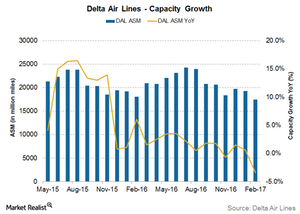Delta Air Lines: On the Right Route to Achieve Capacity Guidance?
Delta Air Lines (DAL) has maintained a low-capacity growth profile throughout 2017. For May 2017, DAL’s capacity growth was flat at 22,072 million miles.
Aug. 18 2020, Updated 5:27 a.m. ET

Capacity growth
Delta Air Lines (DAL) has maintained a low-capacity growth profile throughout 2017. For May 2017, its capacity growth was flat at 22,072 million miles. Year-to-date (or YTD) as of May 2017, Delta’s capacity has fallen 0.40% YoY (year-over-year) to 100,569 million miles. That was mainly due to the 3.4% YoY fall in February 2017.
Domestic demand remains strong
Delta Air Lines’ domestic region capacity grew in May 2017 at 2.1% YoY after recording a fall of 0.10% in April 2017. However, domestic capacity has been mostly improving in 2017 with a YTD capacity growth of 1.4% YoY.
None of DAL’s peers, including American Airlines (AAL), United Continental Holdings (UAL), and Alaska Air Group (ALK), have reported May 2017 results.
International capacity fell
Despite the rise in domestic capacity, DAL’s capacity was flat due to the huge fall in international capacity. International capacity fell 3.1% YoY in May 2017. In fact, it has been falling throughout 2017. The reason for the fall is weaker international yields compared to domestic yields.
YTD as of May 2017, DAL’s international capacity has fallen 3.3% YoY. The Pacific region has seen the highest fall in capacity at 10.7% YoY. For the same period, the Atlantic market capacity fell 1.8% YoY, while the Latin American capacity rose 1.5% YoY.
Outlook
In its March 2017 earnings release, Delta Air Lines gave a guidance of 0.0%–1.0% for total capacity growth for 2Q17. In the first two months of the quarter, the airline had an average growth of -0.80% YoY. That means investors can expect some capacity growth for the next month.
In the next part of this series, we’ll look at DAL’s capacity growth for the month. You can gain exposure to airlines by investing in the iShares Transportation Average (IYT), which holds 24.0% of its holdings in airline stocks.
